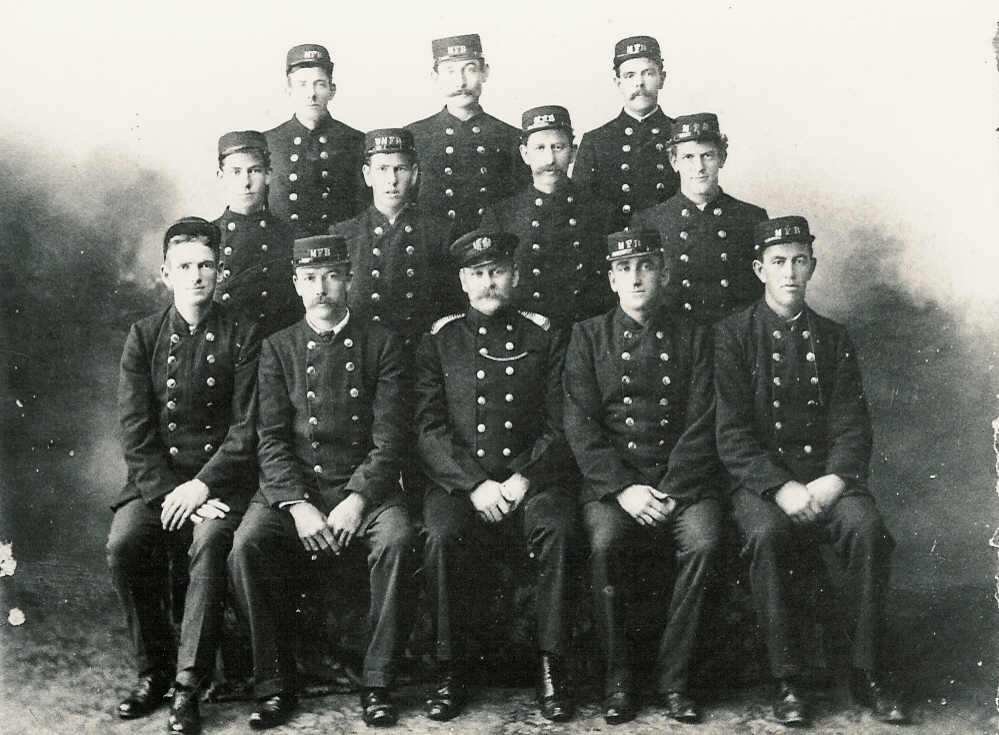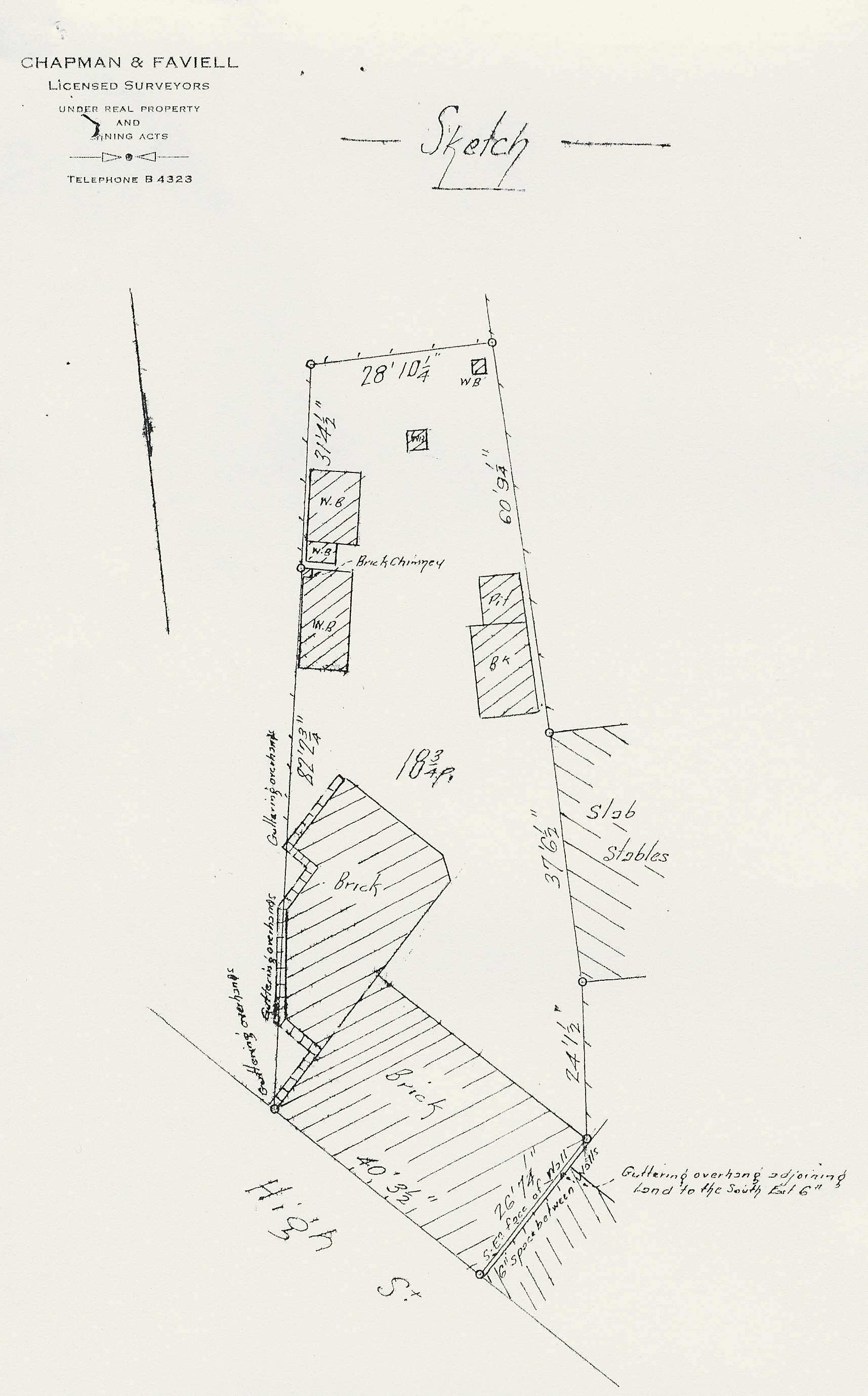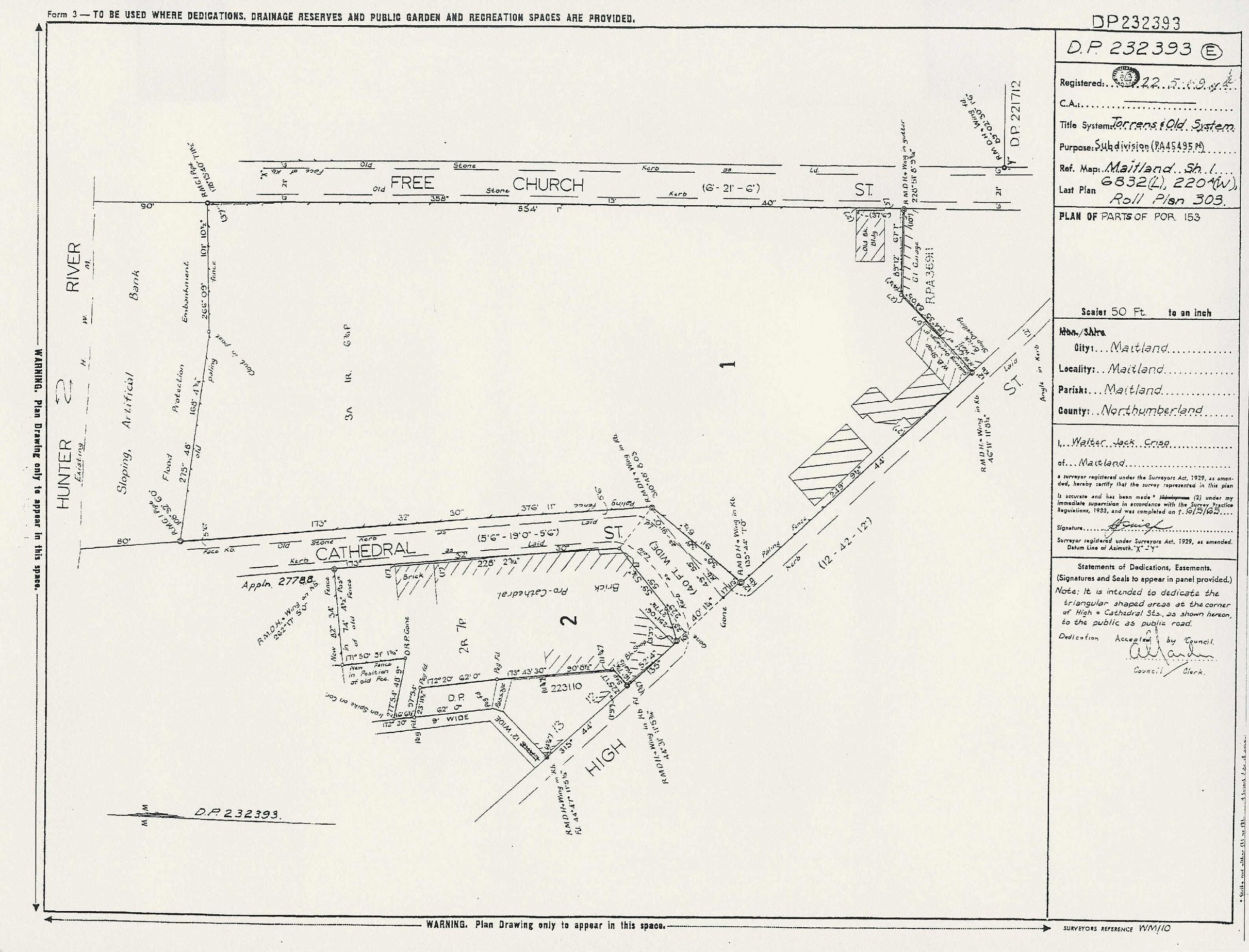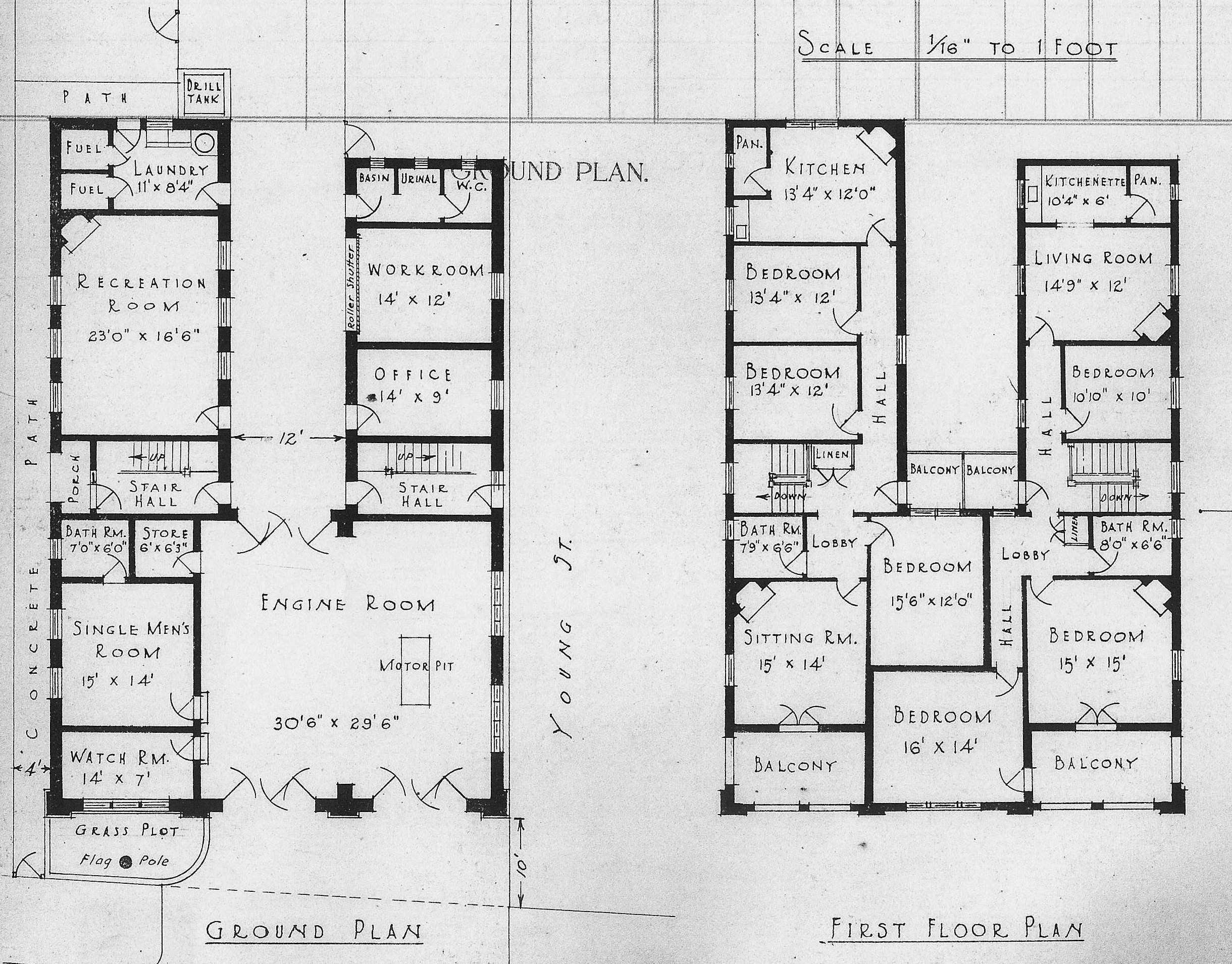West Maitland Fire Brigade
Website editors’ note: In 2011 Maitland and District Historical Society researched information for heritage walks in the city. One of the sites was the Fire Station at 14 Church St. For background, the Society sought assistance from Gary Boyce who, at the time, was archivist and historical researcher with Fire & Rescue NSW, located at the Fire Museum in Penrith. Gary kindly provided the following timeline that traces the early fluctuating history of the West Maitland Fire Brigade and its premises, and provides some detail on the two main fire stations. Gary has given his permission to share his research online.
The fire station at 14 Church St, Maitland, 2018
The Brigade
Formation
May 1856: A fire engine was donated to the township as a ‘joint gift’ from several of the Insurance Companies in Sydney. (Maitland Mercury, 3 May 1856)
12 May 1856: A public meeting took place at the William Denison Inn for the purpose of deciding where the new engine might be permanently housed, to arrange for subscriptions to erect an engine house, and to form a volunteer fire brigade. A number of citizens enrolled to become members of the brigade. (MM, 10 and 15 May 1856)
23 June 1856: A meeting was held at East Maitland, at which time further names were added to the roll. The following evening another meeting was held at William Denison’s Inn to receive the signatures of those who had volunteered and to elect the office bearers of the brigade:
It was stated that those who placed their names on the roll, and paid the 5s entrance money, would receive the red shirt of the brigade uniform. Twelve helmets had been procured, and fourteen were now at disposal. Several volunteers then came forward and signed the roll, the number of signatures at the close of the meeting being thirteen.
It appears that the cost of helmets had been greater than expected, therefore, the twelve that had been procured were to be ‘balloted for amongst the volunteers’. (MM, 26 June 1856)
Disbandment and reformation
1859 - Disbanded: By 1859 there was no fire brigade in the town.
November 1859: A meeting was held for the purpose of reforming the Maitland Fire Brigade, but this would appear to have been unsuccessful, for in 1864, an article in the Maitland Mercury emphasises the danger in a town having no fire brigade. (MM, 24 Nov 1859 and 23 Jan 1864).
July 1864: Meetings again occurred for the purpose of reforming the brigade.
1865: West Maitland Fire Brigade was once again responding to fires - and annoying the public with excessive ringing of their fire bell! (MM, 16 Mar and 27 Jul 1865)
1867: It would appear that the brigade once again disbanded.
A letter to the editor in the Maitland Mercury in 1867 defends certain criticisms that had been levelled at the late brigade:
It is pretty well known in the town how the late fire brigade attended to and worked the fire engine willingly and well, for the first year of their engagement, for which they were duly paid. Agreements were signed for another year of the due performance of our several duties which was faithfully carried out by the brigade, but not the agents … (MM, 22 Jan 1867)
The ‘agents’ were the members of the Fire Brigade Committee. A dispute arose over non-payment of the firemen’s salary. It was asserted by the writer that there was an agreement whereby the volunteer firemen would receive some form of remuneration for their services (although the Secretary rejected any such agreement).The letter continues:
… At the expiration of the second year, application was made for our salary, which after repeated applications could not be obtained …
1866: By the end of 1866 the town’s fire protection was in disarray (no brigade).
Jan 1867: The Council received a letter from the Sydney insurance companies, informing it that unless a genuine volunteer brigade was formed under the control and supervision of the Council, then the fire engine and equipment would be withdrawn. (MM, 8 Jan 1867)
Subsequent articles in the Maitland Mercury indicate that the Council took such action, albeit belatedly.
Oct 1867: A reformed brigade held its first half yearly meeting, announcing the receipt of £72 from the insurance companies. (MM, 5 Oct 1867)
1871: By March 1871 the brigade once again had ‘collapsed’ and a meeting was held in April, during which a committee was appointed for the purpose of re-forming the brigade. (MM, 21 Mar 1871 and 29 Apr 1871)
1876: The brigade was again operating and seeking a site upon which to erect a fire station. (MM, 28 Sep 1876)
1877: The Brigade was operating under the supervision of the West Maitland Fire Brigade Board. (BFCNSW Land and Station Registers Book 1)
Maitland Fire Brigade members, pre-1910
(Fire & Rescue NSW, Historical Photograph Collection, located at Museum of Fire, Penrith)
Fire Stations 1857-1878
The brigade was located at a number of sites between 1857 and 1878. The location details, however, are vague.
June 1856: The engine was initially stored at ‘Mr Gorrick’s yard’, free of charge, until an engine house could be erected. At a meeting on 23 June 1856, the specifications for an engine house were viewed:
From an inspection of the plans and specifications for the engine-house, it appears that the building will be a neat erection 18 feet 30 inches by 10 feet 10 inches wide, of hardwood, weatherboarded, with three small windows; the roof being of galvanised iron. The whole would be easily removable in case of necessity by means of rollers. (MM, 26 June 1856)
Three gentlemen (Messrs Wade, Stark and Dobbs) all made offers of land, on a ‘long lease, gratis’ basis. (MM, 15 May and 26 June 1856)
April 1857: The engine was installed in the new engine house - in High Street:
The Maitland fire engine has been this week installed in its proper building, the house erected on the ground of the Messrs Dickson and Co, High-street, adjoining Mr Melville’s. This is a central site, and can conveniently be reached from any spot where the services of the engine may be unhappily required. Several keys to the house have been obtained, the better to secure immediate admission in case of fire. A key has therefore been left with each of the following gentlemen …(MM, 25 April 1857)
1867: Following a number of disbandments and reformations over the next ten years, the brigade rented premises (location/s unknown). (MM, 5 April 1870)
April 1870: The brigade was situated in an engine house located on the premises of Isaac Gorrick, free of charge.(MM, 5 April 1870)
1876: The fire station was located at Elgin Street, for it was reported that a crowd assembled at ‘High and Elgin Streets’ to watch the brigade turn out to a fire:
About half-past nine o'clock on Saturday night the town was startled by the sound of the fire bell, and a crowd quickly assembled at the corner of High and Elgin Streets. In a very short time the engine was manned, and proceeded to Durham Street from whence the alarm had come. (MM, 29 Feb 1876)
Dec 1877: The West Maitland Fire Brigade Committee announced that it was proposing to purchase a site next to the Plough Inn for the purpose of erecting a fire station. (MM, 11 Dec 1877)
In 1926, former Superintendent of the West Maitland Volunteer Fire Brigade, C.T. Phillips, wrote:
… The Brigade vacated their old station off Elgin Street and took up their quarters at the New Station on the 5th July 1878. (Fire and Rescue Archive)
High Street Fire Station 1878-1930
1 March 1877: The West Maitland Fire Brigade Board purchased land fronting High Street from the trustees of the estate of the late J Halpin, for £400. A fire station was erected on this site in 1878 and was first occupied on 5 July that year. (BFCNSW Land and Station Registers)
20 May 1878: The station was described in the Maitland Mercury as located ‘on the allotment of land next to the Plough Inn’. The builder was James Pritchard; the architect was J.W. Pender. (MM, 30 May 1878)
NSW Fire Brigade plan showing the High Street fire station and site, 1916
The plan is attached to Thomas Gorman to Nicholas Sparkes, memorandum, 2 June 1916, Fire & Rescue NSW, Historical Archives, Box 266, located at the Museum of Fire, Penrith NSW.
19 December 1910: With West Maitland Fire Brigade having come under the Fire Brigades Act (1909), ownership of the premises was transferred from the Trustees of the West Maitland Fire Brigade Board (George Cohen and John Lee) to the Board of Fire Commissioners. (BFCNSW Land and Station Registers)
High Street Fire Station, about 1914 and 1917
click on images for larger views
Surveyor’s plan showing the irregular shape of the site and the configuration of the buildings, 1924
(Fire & Rescue NSW, Historical Archive, Box 266, located at Museum of Fire, Penrith)
1916: Board of Fire Commissioners’ records establish that the station was considered to be inadequate for its purpose owing to its irregular shape and the lack of vehicular access to the rear yard. It was also located within the flood zone. It was therefore suggested that the station might be sold and a more suitable site purchased. Indeed, the Right Reverend P.V. Dwyer, Bishop of Maitland, made the Board an offer, but the Board declined. It was not until 1930 that the Board took action in the matter.
1929: The High Street station was put up for auction, on the condition that the new owner would not occupy the premises until 30 June 1930. In the meantime, a tender was accepted for a new station in Church Street.
The auction was held on 11 December 1929 and this time Bishop Dwyer was successful in purchasing the fire station - for £1587/10/-. It was described at the time as:
… a building of two floors of brick construction and iron roof. On the ground floor [was] a double Engine House, Watchroom, Store, &c., while the quarters [were] on the first floor above the Watchroom. (BFCNSW records)
1969: A Deposited Plan at the Lands Department NSW (DP232393, 22 May 1969) shows that the fire station was still in existence in 1969. It has since been demolished.
Deposited Plan (DP 232393, 22 May 1969), NSW Dept of Lands
Church Street Fire Station, 1930 -
The current fire station building, on the corner of Church and Young Streets, was provided by the Board of Fire Commissioners of NSW, in 1930. The site was purchased in two lots from Charles Wellington Holmes at a total cost of £1260, during 1928 and 1929. The building was erected by G. Pilgrim at a contract price of £5991/19/6. It was occupied by the brigade on 30 May 1930. (BFCNSW records)
In 1930, the building was described as:
… of two floors constructed of brick with a fibro slate roof. The ground floor comprises a double engine room, Watchroom, Singlemen’s room, Bathroom, Recreation room, Stores, Offices, &c. Whilst on the first floor there are two sets of quarters, that for the officer having a larger kitchen …(BFCNSW records)
Floor plan of Church Street station
(Board of Fire Commissioners of NSW, ‘Land and Station Registers’, book 1, p. 58, original located at Fire and Rescue NSW Information Management.)
Based on floor plan, the station is typical of the ‘large’ country stations of the era, and was designed for a brigade that includes both members of the permanent staff and volunteer firemen. It provided residential accommodation for the two permanent staff members – in this case a Sub-Station Officer and a First Class Fireman. Thus, two sets of quarters were located upstairs. The fact that they were completely segregated denotes a difference in rank, as does the fact that the officer’s quarters were more spacious.
It is typical that the residential area was upstairs, away from the operational and recreational areas downstairs (where the permanent and volunteer firemen would perform their duties, drills, or simply socialise). Recreational rooms were an important part of fire stations during this era, since those permanent staff who were based at country stations were still on the ‘120 hour week’ – in other words, confined to the station for five (twenty-four hour) days out of seven, and with two (separate) twenty four hour breaks - Sydney and Newcastle based firemen had, by this time, won a new two-platoon rotating roster in 1928, reducing their working hours to eighty four and allowing them to live away from the station. With respect to the (ten) volunteer firemen, it was generally accepted at the time that recreational facilities encouraged volunteers to spend more time at the station thus, if a fire call was received, they would be on hand to respond in quick time. Most probably, the recreation room contained a pool, or snooker, table. The Board of Fire Commissioners, or the local community, usually supplied these. The recreational room, and the engine room, were also places to hold occasional social events (eg the Christmas Party, smoke concerts/dances; etc) - with the Board’s approval, of course.
The double engine bay is also typical of a large country station, allowing for more than one engine, if required.
Other points of interest:
The Builder: Mr G. Pilgrim, an old resident of Maitland, made a special request to the Board. A report to the Board from William McNiven (Architect) stated:
In connection with the erection of the above Station, the builder Mr Pilgrim is a very old resident of Maitland and is (sic) associated with the Local Municipal Council and public movements of the town for many years. [He] would appreciate the Board’s approval for a small brass tablet bearing his name as builder of the New Station to be placed in the engine room of same. Mr Pilgrim would defray the cost of the tablet. The size of this would be about 9” by 3” and attached to face of the pier on the rear wall of the engine room.
In recommending this proposal, I would like to point out that Mr Pilgrim has taken a very keen interest in this work and has turned out an exceptionally well finished building of which he is very proud. (BFCNSW records)
In April 2011 the brass plaque was still in situ.*
*Website editors’ note: Is it still in situ in 2025? If it is, a photo would be great.
The Architect: The architect who designed this building was William McNiven. He was the Board’s first ‘in-house’ architect. Previously, the Board’s fire stations had been designed by the Government Architect (Barnett, Vernon, etc.,), followed by the firm of Spain, Cosh & Minett. McNiven joined the Metropolitan Fire Brigade as a probationary fireman on 1 May 1900. A carpenter by trade, he was appointed ‘Clerk of Works’ in 1916. In 1918, the position was upgraded to ‘Officer in charge of Construction’, and then in 1923, he was registered as an architect. He retired in 1931.
Note: Cynthia Hunter’s account of fires in Maitland on pp 43-47 of her Out of the Closet: Maitland’s Water Stories, Maitland, 2006 provides context on the ever-present risk of fires as well as insights into the water supplies and suppliers needed to fight the fires.
References
Board of Fire Commissioners of NSW (BFCNSW), Land and Station Registers, Book 1, p 58, Fire and Rescue NSW Information Management.
BFCNSW, Minute Books 1910-1959 and Personnel Record Books, 1884-1955, State Records NSW, NRS 473 and 510.
Fire & Rescue NSW Historical Archive:
BFCNSW, Visit of Inspection, 15 and 16 May 1916, unpub. report.
BFCNSW, Conditions and Terms of Sale, 11 Dec 1929.
CT Phillips to Station Officer G Turner, letter, 27 Jan 1926.
BFCNSW, Data for Board’s Inspection, 1 July 1930.
Frank Turner statutory declaration, Feb 1926,.
G Turner to W Hillier, letter, 1 Feb 1926
P V Dwyer to Henry Webb, letter, 19 May 1916.
Thomas Gorman to Nicholas Sparkes, memorandum, 2 June 1916.
Maitland Mercury








